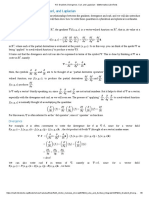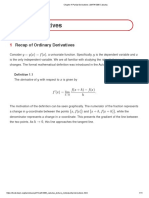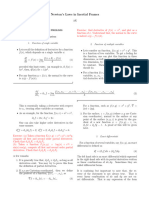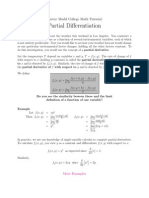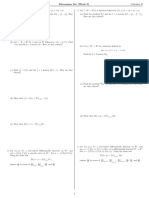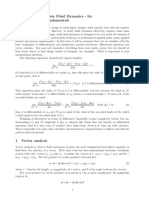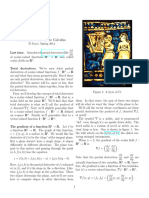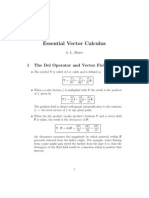4.06 Gradient Divergence Curl and Laplacian
4.06 Gradient Divergence Curl and Laplacian
Uploaded by
Muhammad Farid ShahidCopyright:
Available Formats
4.06 Gradient Divergence Curl and Laplacian
4.06 Gradient Divergence Curl and Laplacian
Uploaded by
Muhammad Farid ShahidCopyright
Available Formats
Share this document
Did you find this document useful?
Is this content inappropriate?
Copyright:
Available Formats
4.06 Gradient Divergence Curl and Laplacian
4.06 Gradient Divergence Curl and Laplacian
Uploaded by
Muhammad Farid ShahidCopyright:
Available Formats
4.
6: Gradient, Divergence, Curl, and Laplacian
In this final section we will establish some relationships between the gradient, divergence and curl, and we will also introduce a
new quantity called the Laplacian. We will then show how to write these quantities in cylindrical and spherical coordinates.
Gradient
For a real-valued function f (x, y, z) on R , the gradient ∇f (x, y, z) is a vector-valued function on R , that is, its value at a point
3 3
(x, y, z) is the vector
∂f ∂f ∂f ∂f ∂f ∂f
∇f (x, y, z) = ( , , ) = i+ j+ k
∂x ∂y ∂z ∂x ∂y ∂z
in R , where each of the partial derivatives is evaluated at the point
3
(x, y, z) . So in this way, you can think of the symbol ∇ as
being “applied” to a real-valued function f to produce a vector ∇f .
It turns out that the divergence and curl can also be expressed in terms of the symbol ∇. This is done by thinking of ∇ as a vector
in R , namely
3
∂ ∂ ∂
∇ = i+ j+ k. (4.6.1)
∂x ∂y ∂z
∂ ∂ ∂
Here, the symbols , and are to be thought of as “partial derivative operators” that will get “applied” to a real-valued
∂x ∂y ∂z
∂f ∂f ∂f ∂
function, say f (x, y, z) , to produce the partial derivatives , and . For instance, “applied” to
∂x ∂y ∂z ∂x
∂f
f (x, y, z) produces .
∂x
∂ ∂ ∂
Is ∇ really a vector? Strictly speaking, no, since , and are not actual numbers. But it helps to think of ∇ as a vector,
∂x ∂y ∂z
∂ ∂ ∂
especially with the divergence and curl, as we will soon see. The process of “applying” , , to a real-valued function
∂x ∂y ∂z
f (x, y, z) is normally thought of as multiplying the quantities:
∂ ∂f ∂ ∂f ∂ ∂f
( ) (f ) = , ( ) (f ) = , ( ) (f ) =
∂x ∂x ∂y ∂y ∂z ∂z
For this reason, ∇ is often referred to as the “del operator”, since it “operates” on functions.
Divergence
For example, it is often convenient to write the divergence div f as ∇ ⋅ f , since for a vector field
f(x, y, z) = f (x, y, z)i + f (x, y, z)j + f (x, y, z)k , the dot product of f with ∇ (thought of as a vector) makes sense:
1 2 3
∂ ∂ ∂
∇⋅f =( i+ j+ k) ⋅ (f1 (x, y, z)i + f2 (x, y, z)j + f3 (x, y, z)k)
∂x ∂y ∂z
∂ ∂ ∂
=( ) (f1 ) + ( ) (f2 ) + ( ) (f3 )
∂x ∂y ∂z
∂f1 ∂f2 ∂f3
= + +
∂x ∂y ∂z
= div f
We can also write curl f in terms of ∇, namely as ∇×f , since for a vector field
f(x, y, z) = P (x, y, z)i + Q(x, y, z)j + R(x, y, z)k , we have:
GNU Free Documentation License 4.6.1 https://math.libretexts.org/@go/page/2241
∣ i j k ∣
∣ ∣
∣ ∂ ∂ ∂ ∣
∇×f = ∣ ∣
∣ ∂x ∂y ∂z ∣
∣ ∣
∣ P (x, y, z) Q(x, y, z) R(x, y, z) ∣
∂R ∂Q ∂R ∂P ∂Q ∂P
=( − ) i−( − ) j +( − )k
∂y ∂z ∂x ∂z ∂x ∂y
∂R ∂Q ∂P ∂R ∂Q ∂P
=( − ) i+( − ) j +( − )k
∂y ∂z ∂z ∂x ∂x ∂y
= curl f
∂f ∂f ∂f
For a real-valued function f (x, y, z), the gradient ∇f (x, y, z) = i+ j+ k is a vector field, so we can take its
∂x ∂y ∂z
divergence:
div ∇f = ∇ ⋅ ∇f
∂ ∂ ∂ ∂f ∂f ∂f
=( i+ j+ k) ⋅ ( i+ j+ k)
∂x ∂y ∂z ∂x ∂y ∂z
∂ ∂f ∂ ∂f ∂ ∂f
= ( )+ ( )+ ( )
∂x ∂x ∂y ∂y ∂z ∂z
2 2 2
∂ f ∂ f ∂ f
= + +
∂x2 ∂y 2 ∂z 2
Note that this is a real-valued function, to which we will give a special name:
Definition 4.7: Laplacian
For a real-valued function f (x, y, z), the Laplacian of f , denoted by Δf , is given by
2 2 2
∂ f ∂ f ∂ f
Δf (x, y, z) = ∇ ⋅ ∇f = + + . (4.6.2)
2 2 2
∂x ∂y ∂z
Often the notation ∇ 2
f is used for the Laplacian instead of Δf , using the convention ∇ 2
= ∇⋅∇ .
Example 4.17
Let r(x, y, z) = xi + yj + zk be the position vector field on R . Then ∥r(x, y, z)∥ 3 2
= r⋅ r = x
2
+y
2
+z
2
is a real-valued
function. Find
a. the gradient of ∥r∥ 2
b. the divergence of r
c. the curl of r
d. the Laplacian of ∥r∥ 2
Solution:
(a) ∇∥r∥ 2
= 2xi + 2yj + 2zk = 2r
∂ ∂ ∂
(b) ∇ ⋅ r = (x) + (y) + (z) = 1 + 1 + 1 = 3
∂x ∂y ∂z
(c)
∣ i j k ∣
∣ ∣
∣ ∂ ∂ ∂ ∣
∇×r = ∣ ∣ = (0 − 0)i − (0 − 0)j + (0 − 0)k = 0
∣ ∂x ∂y ∂z ∣
∣ ∣
∣ x y z ∣
GNU Free Documentation License 4.6.2 https://math.libretexts.org/@go/page/2241
2 2 2
∂ ∂ ∂
(d) Δ∥r∥ 2
=
2
2
(x +y
2 2
+z )+
2
(x
2
+y
2
+z )+
2
2
(x
2
+y
2 2
+z ) = 2 +2 +2 = 6
∂x ∂y ∂z
Note that we could have calculated Δ∥r∥ another way, using the ∇ notation along with parts (a) and (b):
2
2 2
Δ∥r∥ = ∇ ⋅ ∇∥r∥ = ∇ ⋅ 2r = 2∇ ⋅ r = 2(3) = 6
Notice that in Example 4.17 if we take the curl of the gradient of ∥r∥ we get 2
2
∇ × (∇∥r∥ ) = ∇ × 2r = 2∇ × r = 20 = 0.
The following theorem shows that this will be the case in general:
Theorem 4.15.
For any smooth real-valued function f (x, y, z), ∇ × (∇f ) = 0 .
Proof
We see by the smoothness of f that
∣ i j k ∣
∣ ∣
∣ ∂ ∂ ∂ ∣
∣ ∣
∇ × (∇f ) = ∂x ∂y ∂z (4.6.3)
∣ ∣
∣ ∣
∂f ∂f ∂f
∣ ∣
∣ ∂x ∂y ∂z ∣
2 2 2 2 2 2
∂ f ∂ f ∂ f ∂ f ∂ f ∂ f
=( − ) i−( − ) j +( − ) k = 0, (4.6.4)
∂y∂z ∂z∂y ∂x∂z ∂z∂x ∂x∂y ∂y∂x
since the mixed partial derivatives in each component are equal.
□
Corollary 4.16
If a vector field f (x, y, z) has a potential, then curl f = 0 .
Another way of stating Theorem 4.15 is that gradients are irrotational. Also, notice that in Example 4.17 if we take the divergence
of the curl of r we trivially get
∇ ⋅ (∇ × r) = ∇ ⋅ 0 = 0. (4.6.5)
The following theorem shows that this will be the case in general:
Theorem 4.17.
For any smooth vector field f(x, y, z), ∇ ⋅ (∇ × f) = 0.
The proof is straightforward and left as an exercise for the reader.
Corollary 4.18
The flux of the curl of a smooth vector field f (x, y, z) through any closed surface is zero.
Proof: Let Σ be a closed surface which bounds a solid S . The flux of ∇ × f through Σ is
GNU Free Documentation License 4.6.3 https://math.libretexts.org/@go/page/2241
∬ (∇ × f) ⋅ dσ =∭ ∇ ⋅ (∇ × f) dV (by the Divergence Theorem) (4.6.6)
Σ S
=∭ 0 dV (by Theorem 4.17) (4.6.7)
=0 (4.6.8)
(QED)
There is another method for proving Theorem 4.15 which can be useful, and is often used in physics. Namely, if the surface integral
∬ f (x, y, z) dσ = 0 for all surfaces Σ in some solid region (usually all of R ), then we must have f (x, y, z) = 0 throughout that
3
region. The proof is not trivial, and physicists do not usually bother to prove it. But the result is true, and can also be applied to
double and triple integrals.
For instance, to prove Theorem 4.15, assume that f (x, y, z) is a smooth real-valued function on R . Let C be a simple closed curve
3
in R and let Σ be any capping surface for C (i.e. Σ is orientable and its boundary is C ). Since ∇f is a vector field, then
3
∬ (∇ × (∇f )) ⋅ n dσ =∮ ∇f ⋅ dr by Stokes’ Theorem, so
C
Σ
= 0 by Corollary 4.13.
Since the choice of Σ was arbitrary, then we must have (∇ × (∇f )) ⋅ n = 0 throughout R , where n is any unit vector. Using i, j
3
and k in place of n, we see that we must have ∇ × (∇f ) = 0 in R , which completes the proof.
3
Example 4.18
A system of electric charges has a charge density ρ(x, y, z) and produces an electrostatic field E(x, y, z) at points (x, y, z) in
space. Gauss’ Law states that
∬ E ⋅ dσ = 4π ∭ ρ dV
Σ S
for any closed surface Σ which encloses the charges, with S being the solid region enclosed by Σ . Show that ∇ ⋅ E = 4πρ .
This is one of Maxwell’s Equations.
Solution
By the Divergence Theorem, we have
∭ ∇ ⋅ EdV =∬ E ⋅ dσ
S Σ
= 4π ∭ ρ dV by Gauss’ Law, so combining the integrals gives
∭ (∇ ⋅ E − 4πρ) dV = 0 , so
∇ ⋅ E − 4πρ = 0 since Σ and hence S was arbitrary, so
∇ ⋅ E = 4πρ.
Often (especially in physics) it is convenient to use other coordinate systems when dealing with quantities such as the gradient,
divergence, curl and Laplacian. We will present the formulas for these in cylindrical and spherical coordinates.
Recall from Section 1.7 that a point (x, y, z) can be represented in cylindrical coordinates
(r, θ, z), where x = r cos θ, y = r sin θ, z = z. At each point
GNU Free Documentation License 4.6.4 https://math.libretexts.org/@go/page/2241
(r, θ, z), let er , eθ , ez be unit vectors in the direction of increasing r, θ, z, respectively (see Figure 4.6.1). Then er , eθ , ez
form an orthonormal set of vectors. Note, by the right-hand rule, that e z × er = eθ .
Figure 4.6.1 Orthonormal vectors e r, eθ , ez in cylindrical coordinates (left) and spherical coordinates (right).
Similarly, a point be
(x, y, z) represented canin spherical coordinates (ρ, θ, φ), where
x = ρ sin φ cos θ, y = ρ sin φ sin θ, z = ρ cos φ. At each point (ρ, θ, φ), let e , e , e be unit vectors in the direction of increasing
ρ θ φ
ρ, θ, φ, respectively (see Figure 4.6.2). Then the vectors e , e , e are orthonormal. By the right-hand rule, we see that
ρ θ φ
e ×e = e
θ ρ . φ
We can now summarize the expressions for the gradient, divergence, curl and Laplacian in Cartesian, cylindrical and spherical
coordinates in the following tables:
Cartesian
(x, y, z) : Scalar function F ; Vector field f = f 1i + f2 j + f3 k
∂F ∂F ∂F
gradient : ∇F = i+ j+ k
∂x ∂y ∂z
∂f1 ∂f2 ∂f3
divergence : ∇ ⋅ f = + +
∂x ∂y ∂z
∂f3 ∂f2 ∂f1 ∂f3 ∂f2 ∂f1
curl : ∇ × f = ( − ) i+( − ) j +( − )k
∂y ∂z ∂z ∂x ∂x ∂y
2 2 2
∂ F ∂ F ∂ F
Laplacian : ΔF =
2
+
2
+
2
∂x ∂y ∂z
Cylindrical
(r, θ, z) : Scalar function F ; Vector field f = f r er + fθ eθ + fz ez
∂F 1 ∂F ∂F
gradient : ∇F = er + eθ + ez
∂r r ∂θ ∂z
1 ∂ 1 ∂fθ ∂fz
divergence : ∇ ⋅ f = (rfr ) + +
r ∂r r ∂θ ∂z
1 ∂fz ∂fθ ∂fr ∂fz 1 ∂ ∂fr
curl : ∇ × f = ( − ) er + ( − ) eθ + ( (rfθ ) − ) ez
r ∂θ ∂z ∂z ∂r r ∂r ∂θ
2 2
1 ∂ ∂F 1 ∂ F ∂ F
Laplacian : ΔF = (r )+
2 2
+
2
r ∂r ∂r r ∂θ ∂z
GNU Free Documentation License 4.6.5 https://math.libretexts.org/@go/page/2241
Spherical
(ρ, θ, φ) : Scalar function F ; Vector field f = f ρ eρ + fθ eθ + fφ eφ
∂F 1 ∂F 1 ∂F
gradient : ∇F = eρ + eθ + eφ
∂ρ ρ sin φ ∂θ ρ ∂φ
1 ∂ 1 ∂fθ 1 ∂
divergence : ∇ ⋅ f = 2
2
(ρ fρ ) + sin φ + (sin φ fθ )
ρ ∂ρ ρ ∂θ ρ sin φ ∂φ
1 ∂ ∂fφ 1 ∂ ∂fρ 1 ∂fρ 1 ∂
curl : ∇ × f = ( (sin φ fθ ) − ) eρ + ( (ρfφ ) − ) eθ + ( − (ρfθ )) eφ
ρ sin φ ∂φ ∂θ ρ ∂ρ ∂φ ρ sin φ ∂θ ρ ∂ρ
2
1 ∂ ∂F 1 ∂ F 1 ∂ ∂F
Laplacian : ΔF =
2
(ρ
2
)+
2 2
+
2
(sin φ )
ρ ∂ρ ∂ρ 2 ρ sin φ ∂φ ∂φ
ρ sin φ ∂θ
The derivation of the above formulas for cylindrical and spherical coordinates is straightforward but extremely tedious. The basic
idea is to take the Cartesian equivalent of the quantity in question and to substitute into that formula using the appropriate
coordinate transformation. As an example, we will derive the formula for the gradient in spherical coordinates.
Goal: Show that the gradient of a real-valued function F (ρ, θ, φ) in spherical coordinates is:
∂F 1 ∂F 1 ∂F
∇F = eρ + eθ + eφ
∂ρ ρ sin φ ∂θ ρ ∂φ
∂F ∂F ∂F
Idea: In the Cartesian gradient formula ∇F (x, y, z) = i+ j+ k , put the Cartesian basis vectors i, j, k in terms of the
∂x ∂y ∂z
∂F ∂F ∂F
spherical coordinate basis vectors e ρ, eθ , eφ and functions of ρ, θ and φ . Then put the partial derivatives , , in terms
∂x ∂y ∂z
∂F ∂F ∂F
of , , and functions of ρ, θ and φ .
∂ρ ∂θ ∂φ
Step 1: Get formulas for e ρ, eθ , eφ in terms of i, j, k.
We can see from Figure 4.6.2 that the unit vector eρ in the ρ direction at a general point (ρ, θ, φ) is
r
eρ = , where r = xi + yj + zk is the position vector of the point in Cartesian coordinates. Thus,
∥r∥
r xi + yj + zk
eρ = = ,
−−−−−−−−−−
∥r∥ 2 2 2
√x +y +z
−−−−−−−−− −
so using x = ρ sin φ cos θ, y = ρ sin φ sin θ, z = ρ cos φ, 2 2
and ρ = √x + y + z
2
, we get:
eρ = sin φ cos θi + sin φ sin θj + cos φk
Now, since the angle θ is measured in the xy-plane, then the unit vector e in the θ direction must be parallel to the xy-plane. That θ
is, e is of the form ai + bj + 0k . To figure out what a and b are, note that since e ⊥ e , then in particular e ⊥ e when
θ θ ρ θ ρ
e is in the xy -plane.
ρ That occurs when the angle φ is π/2. Putting φ = π/2 into the formula for
e gives e = cos θi + sin θj + 0k , and we see that a vector perpendicular to that is − sin θi + cos θj + 0k . Since this vector is
ρ ρ
also a unit vector and points in the (positive) θ direction, it must be e : θ
eθ = − sin θi + cos θj + 0k
Lastly, since e φ = eθ × eρ , we get:
eφ = cos φ cos θi + cos φ sin θj − sin φk
Step 2: Use the three formulas from Step 1 to solve for i, j, k in terms of e ρ, eθ , eφ .
This comes down to solving a system of three equations in three unknowns. There are many ways of doing this, but we will do it by
combining the formulas for e and e to eliminate k , which will give us an equation involving just i and j. This, with the formula
ρ φ
for e , will then leave us with a system of two equations in two unknowns (i and j), which we will use to solve first for j then for i.
θ
Lastly, we will solve for k.
GNU Free Documentation License 4.6.6 https://math.libretexts.org/@go/page/2241
First, note that
sin φ eρ + cos φ eφ = cos θi + sin θj
so that
2 2
sin θ(sin φ eρ + cos φ eφ ) + cos θeθ = (sin θ + cos θ)j = j,
and so:
j = sin φ sin θeρ + cos θeθ + cos φ sin θeφ
Likewise, we see that
2 2
cos θ(sin φ eρ + cos φ eφ ) − sin θeθ = (cos θ + sin θ)i = i,
and so:
i = sin φ cos θeρ − sin θeθ + cos φ cos θeφ
Lastly, we see that:
k = cos φ eρ − sin φ eφ
∂F ∂F ∂F ∂F ∂F ∂F
Step 3: Get formulas for , , in terms of , , .
∂ρ ∂θ ∂φ ∂x ∂y ∂z
By the Chain Rule, we have
∂F ∂F ∂x ∂F ∂y ∂F ∂z
= + + ,
∂ρ ∂x ∂ρ ∂y ∂ρ ∂z ∂ρ
∂F ∂F ∂x ∂F ∂y ∂F ∂z
= + + ,
∂θ ∂x ∂θ ∂y ∂θ ∂z ∂θ
∂F ∂F ∂x ∂F ∂y ∂F ∂z
= + + ,
∂φ ∂x ∂φ ∂y ∂φ ∂z ∂φ
which yields:
∂F ∂F ∂F ∂F
= sin φ cos θ + sin φ sin θ + cos φ
∂ρ ∂x ∂y ∂z
∂F ∂F ∂F
= −ρ sin φ sin θ + ρ sin φ cos θ (4.6.9)
∂θ ∂x ∂y
∂F ∂F ∂F ∂F
= ρ cos φ cos θ + ρ cos φ sin θ − ρ sin φ
∂φ ∂x ∂y ∂z
∂F ∂F ∂F ∂F ∂F ∂F
Step 4: Use the three formulas from Step 3 to solve for , , in terms of , , .
∂x ∂y ∂z ∂ρ ∂θ ∂φ
Again, this involves solving a system of three equations in three unknowns. Using a similar process of elimination as in Step 2, we
get:
∂F 1 ∂F ∂F ∂F
2
= (ρ sin φ cos θ − sin θ + sin φ cos φ cos θ )
∂x ρ sin φ ∂ρ ∂θ ∂φ
∂F 1 2
∂F ∂F ∂F
= (ρ sin φ sin θ + cos θ + sin φ cos φ sin θ ) (4.6.10)
∂y ρ sin φ ∂ρ ∂θ ∂φ
∂F 1 ∂F ∂F
= (ρ cos φ − sin φ )
∂z ρ ∂ρ ∂φ
GNU Free Documentation License 4.6.7 https://math.libretexts.org/@go/page/2241
∂F ∂F ∂F
Step 5: Substitute the formulas for i, j, k from Step 2 and the formulas for , , from Step 4 into the Cartesian gradient
∂x ∂y ∂z
∂F ∂F ∂F
formula ∇F (x, y, z) = i+ j+ k .
∂x ∂y ∂z
Doing this last step is perhaps the most tedious, since it involves simplifying 3 × 3 + 3 × 3 + 2 × 2 = 22 terms! Namely,
1 ∂F ∂F ∂F
2
∇F = (ρ sin φ cos θ − sin θ + sin φ cos φ cos θ ) (sin φ cos θeρ − sin θeθ + cos φ cos θeφ )
ρ sin φ ∂ρ ∂θ ∂φ
1 ∂F ∂F ∂F
2
+ (ρ sin φ sin θ + cos θ + sin φ cos φ sin θ ) (sin φ sin θeρ + cos θeθ + cos φ sin θeφ )
ρ sin φ ∂ρ ∂θ ∂φ
1 ∂F ∂F
+ (ρ cos φ − sin φ ) (cos φ eρ − sin φ eφ ),
ρ ∂ρ ∂φ
which we see has 8 terms involving eρ , 6 terms involving eθ , and 8 terms involving eφ . But the algebra is straightforward and
yields the desired result:
∂F 1 ∂F 1 ∂F
∇F = eρ + eθ + eφ ✓ (4.6.11)
∂ρ ρ sin φ ∂θ ρ ∂φ
Example 4.19
In Example 4.17 we showed that ∇∥r∥ = 2r and Δ ∥r∥ = 6, where r(x, y, z) = xi + yj + zk
2 2
in Cartesian coordinates.
Verify that we get the same answers if we switch to spherical coordinates.
Solution
Since ∥r∥ = x + y + z = ρ
2 2 2 2 2
in spherical coordinates, let F (ρ, θ, φ) = ρ
2
(so that F (ρ, θ, φ) = ∥r∥
2
). The gradient
of F in spherical coordinates is
∂F 1 ∂F 1 ∂F
∇F = eρ + eθ + eφ
∂ρ ρ sin φ ∂θ ρ ∂φ
1 1
= 2ρeρ + (0)eθ + (0)eφ
ρ sin φ ρ
r
= 2ρeρ = 2ρ , as we showed earlier, so
∥r∥
r
= 2ρ = 2r, as expected. And the Laplacian is
ρ
2
1 ∂ ∂F 1 ∂ F 1 ∂ ∂F
2
ΔF = (ρ )+ + (sin φ )
2 2 2 2 2
ρ ∂ρ ∂ρ ρ sin φ ∂θ ρ sin φ ∂φ ∂φ
1 ∂ 2
1 1 ∂
= (ρ 2ρ) + (0) + (sin φ(0))
2 2 2
ρ ∂ρ ρ sin φ ρ sin φ ∂φ
1 ∂ 3
= (2 ρ ) + 0 + 0
2
ρ ∂ρ
1
2
= (6 ρ ) = 6, as expected.
2
ρ
This page titled 4.6: Gradient, Divergence, Curl, and Laplacian is shared under a GNU Free Documentation License 1.3 license and was authored,
remixed, and/or curated by Michael Corral via source content that was edited to the style and standards of the LibreTexts platform; a detailed edit
history is available upon request.
GNU Free Documentation License 4.6.8 https://math.libretexts.org/@go/page/2241
You might also like
- Navi Loan Account StatementDocument2 pagesNavi Loan Account Statementashish singhNo ratings yet
- Unit VDocument36 pagesUnit Vapi-352822682100% (1)
- Cooling System - Industrial EnginesDocument23 pagesCooling System - Industrial EnginesSyarifuddin RahmanNo ratings yet
- Gradient, Divergence, Curl, and LaplacianDocument8 pagesGradient, Divergence, Curl, and LaplacianIITD MEMNo ratings yet
- Analysis in Many Variables IIDocument17 pagesAnalysis in Many Variables IIA FryNo ratings yet
- MA2E01 Chapter 5Document24 pagesMA2E01 Chapter 5Alaa JawadNo ratings yet
- 6 Vector Operators: 6.1 The Gradient OperatorDocument15 pages6 Vector Operators: 6.1 The Gradient OperatorRoy VeseyNo ratings yet
- KalKulus VektorDocument13 pagesKalKulus VektorMohammad Afrizal100% (1)
- Analytic Function ProjectDocument11 pagesAnalytic Function ProjectSuman Basak100% (2)
- CurlDocument49 pagesCurlkhandakartamim46026No ratings yet
- Differentials and The Chain Rule: F M F F FDocument2 pagesDifferentials and The Chain Rule: F M F F FRajNo ratings yet
- Chapter 4 Partial Derivatives - MATH1006 CalculusDocument11 pagesChapter 4 Partial Derivatives - MATH1006 CalculusHerkhinwale OmoakinNo ratings yet
- Newton's LawDocument8 pagesNewton's Lawbisen.ghritlahare.333No ratings yet
- Lista 2Document8 pagesLista 2Leonardo VicinoNo ratings yet
- Derivatives, Backpropagation, and VectorizationDocument7 pagesDerivatives, Backpropagation, and VectorizationAxel StraminskyNo ratings yet
- ENG 233 Lecture Notes 4Document7 pagesENG 233 Lecture Notes 4David Mitry ThomasNo ratings yet
- Gradient, Divergence, and CurlDocument24 pagesGradient, Divergence, and CurlPekan Ilmiah MatematikaNo ratings yet
- Div, Grad, and Curl: 7.1 The OperatorDocument8 pagesDiv, Grad, and Curl: 7.1 The OperatorSibelŞentürkNo ratings yet
- Partial Differentiation: Harvey Mudd College Math TutorialDocument3 pagesPartial Differentiation: Harvey Mudd College Math TutorialavijitbrNo ratings yet
- BSMA-402 Complex Analysis PDFDocument2 pagesBSMA-402 Complex Analysis PDFMohammad MuquimNo ratings yet
- Session6 2Document7 pagesSession6 2alginbaby989No ratings yet
- Maxwell EqsDocument29 pagesMaxwell Eqszanjabila abilNo ratings yet
- L3a - Directional Derivatives, Tangent Plane & Vector OperatorsDocument14 pagesL3a - Directional Derivatives, Tangent Plane & Vector Operatorskenmwas930No ratings yet
- Partial Derivatives: Calculus On R Seminar 5 2020Document7 pagesPartial Derivatives: Calculus On R Seminar 5 2020catalinNo ratings yet
- State and prove Euler's theorem for three variables and hence find the followingDocument3 pagesState and prove Euler's theorem for three variables and hence find the followingdeyrajdeep2005No ratings yet
- Partial Derivatives PDFDocument21 pagesPartial Derivatives PDFAbeNo ratings yet
- Lecture 9Document5 pagesLecture 9Trb HdrNo ratings yet
- Lec 1Document4 pagesLec 1Vïshü ÇhøūdhãryNo ratings yet
- Vector CalculusDocument13 pagesVector CalculusohhNo ratings yet
- Distribution Theory Generalized Functions Notes: Ivan F WildeDocument66 pagesDistribution Theory Generalized Functions Notes: Ivan F WildeSilviuNo ratings yet
- DerivativesDocument20 pagesDerivativesWho CaresNo ratings yet
- Intermediate Fluid Mechanics (ME563 Course Notes)Document221 pagesIntermediate Fluid Mechanics (ME563 Course Notes)Dinaz Zenobia TamboliNo ratings yet
- Analytic Function:: F (Z) Z F Z Z F (Z)Document6 pagesAnalytic Function:: F (Z) Z F Z Z F (Z)Kazi HabibaNo ratings yet
- wk5 Disc ProbDocument2 pageswk5 Disc Probjoon kimNo ratings yet
- AFD Note01 PDFDocument5 pagesAFD Note01 PDFzcap excelNo ratings yet
- Abstract Partial Differentiation Rules Relating Partial DerivativesDocument3 pagesAbstract Partial Differentiation Rules Relating Partial Derivativesmanasgupta496No ratings yet
- Electromagnetism Basics - Formulas, Solutions, ApplicationsDocument4 pagesElectromagnetism Basics - Formulas, Solutions, Applicationscarlos120munroNo ratings yet
- Composition of Functions of Several VariablesDocument2 pagesComposition of Functions of Several VariablesAmiin HirphoNo ratings yet
- GradientsDocument3 pagesGradientsjd2822978No ratings yet
- 1.5 Differentiation Techniques Power and Sum Difference RulesDocument4 pages1.5 Differentiation Techniques Power and Sum Difference RulesVhigherlearning100% (1)
- Calculus SummaryDocument3 pagesCalculus Summaryvuthulan17062001No ratings yet
- Elijah's Math NotesDocument58 pagesElijah's Math NotesAbdullionNo ratings yet
- Chapter 1 ReviewDocument43 pagesChapter 1 ReviewMouhnad dkaidekNo ratings yet
- F2 NotesDocument11 pagesF2 Notessayandatta1No ratings yet
- Problem Set 3aDocument2 pagesProblem Set 3aYumejiNo ratings yet
- Calculus II - Summary of Lecture #2Document9 pagesCalculus II - Summary of Lecture #2khoanv.23bi14223No ratings yet
- Divergence, Rotational, Geometric and Physical InterpretationDocument13 pagesDivergence, Rotational, Geometric and Physical InterpretationScribdTranslationsNo ratings yet
- Lecture 35: δ-functions, Eigenfunctions of X, and Discrete Variable RepresentationDocument9 pagesLecture 35: δ-functions, Eigenfunctions of X, and Discrete Variable RepresentationTui CohenNo ratings yet
- Handy Hint 1 Physics 521 ASUDocument2 pagesHandy Hint 1 Physics 521 ASUJonah ShoemakerNo ratings yet
- Machine Learning and Pattern Recognition Week 8 - BackpropDocument8 pagesMachine Learning and Pattern Recognition Week 8 - BackpropzeliawillscumbergNo ratings yet
- Velocidad PotencialDocument10 pagesVelocidad PotencialGustavo Adolfo Sierra GuerreroNo ratings yet
- Implicit Function TheoremDocument4 pagesImplicit Function Theoremserialz dramazNo ratings yet
- More On The Cauchy-Riemann Equations: Ryan C. DailedaDocument15 pagesMore On The Cauchy-Riemann Equations: Ryan C. DailedaKay Chan SothearaNo ratings yet
- Partial Differential Equations NotesDocument13 pagesPartial Differential Equations NotesJoshua LinNo ratings yet
- Variational CalculusDocument3 pagesVariational Calculusabsiddou100% (1)
- Essential Vector CalculusDocument7 pagesEssential Vector CalculusAdam BruceNo ratings yet
- 6 Gradient of A Scalar Function: F X F y F ZDocument1 page6 Gradient of A Scalar Function: F X F y F ZakshathNo ratings yet
- Matrix CalculusDocument8 pagesMatrix CalculusfadeevlaNo ratings yet
- Homework13 3Document4 pagesHomework13 3Lawson SangoNo ratings yet
- Aeo Guide NtsDocument325 pagesAeo Guide NtsMuhammad Farid ShahidNo ratings yet
- Pre Writing StageDocument18 pagesPre Writing StageMuhammad Farid ShahidNo ratings yet
- PresentationDocument6 pagesPresentationMuhammad Farid ShahidNo ratings yet
- Name: Muhammad Shahid Adeel Roll Number: BSPHY-22-36 Class: Bs Physics 3 Subject: English-3 Submitted By: ShahidDocument1 pageName: Muhammad Shahid Adeel Roll Number: BSPHY-22-36 Class: Bs Physics 3 Subject: English-3 Submitted By: ShahidMuhammad Farid ShahidNo ratings yet
- Inner Product Space: Def Dot Product:-For X, y R, The Dot Product of X&yDocument5 pagesInner Product Space: Def Dot Product:-For X, y R, The Dot Product of X&yMuhammad Farid ShahidNo ratings yet
- Lec 7 Dipole MomentDocument3 pagesLec 7 Dipole MomentMuhammad Farid ShahidNo ratings yet
- VBT & MOT First YearDocument13 pagesVBT & MOT First YearMuhammad Farid ShahidNo ratings yet
- Lec 5 Types of Chemical Bonding-Liq & Gaseous State of Matter-1Document4 pagesLec 5 Types of Chemical Bonding-Liq & Gaseous State of Matter-1Muhammad Farid ShahidNo ratings yet
- 3.4. PhotonsDocument7 pages3.4. PhotonsMuhammad Farid ShahidNo ratings yet
- Chap5.Whatif and SolverDocument24 pagesChap5.Whatif and SolverMai LinhNo ratings yet
- Business Intelligence, Data Warehousing, Data Mining, Data VisualizationDocument79 pagesBusiness Intelligence, Data Warehousing, Data Mining, Data VisualizationshashwatNo ratings yet
- Rainbow Connectors CRM Datasheet enDocument2 pagesRainbow Connectors CRM Datasheet enBogdan PrascevicNo ratings yet
- Auto-Threshold Peak Detection in Physiological SignalsDocument2 pagesAuto-Threshold Peak Detection in Physiological SignalsTony Ike RobertsNo ratings yet
- Baumslag G. A Course in Mathematical Cryptography 2015Document598 pagesBaumslag G. A Course in Mathematical Cryptography 2015Ovidiu TomaNo ratings yet
- Las - Quarter 3 - Week 1 8Document13 pagesLas - Quarter 3 - Week 1 8mark tolentinoNo ratings yet
- Hearst Tower NotesDocument3 pagesHearst Tower Notesdanishali1090No ratings yet
- RSView 32 - Ordering InformationDocument4 pagesRSView 32 - Ordering Informationrgaliste67No ratings yet
- STM User GuideDocument84 pagesSTM User GuideMiled HoussemNo ratings yet
- Basic Java1 ICT 10Document5 pagesBasic Java1 ICT 10vezekiel518No ratings yet
- Experience in Instrumentation Field: Total - 14 Years: Sudhansu BeheraDocument3 pagesExperience in Instrumentation Field: Total - 14 Years: Sudhansu BeheraSudhansu BeheraNo ratings yet
- MS28937Document1 pageMS28937nizarfebNo ratings yet
- Sensors in Monitoring and Control ApplicationsDocument4 pagesSensors in Monitoring and Control ApplicationsKatherine PierceNo ratings yet
- Main Engine Damage 2015 The Swedish ClubDocument14 pagesMain Engine Damage 2015 The Swedish ClubRalf TholenNo ratings yet
- MT 1033hl Turbo Series 2-E2Document1,046 pagesMT 1033hl Turbo Series 2-E2Lupul NegruNo ratings yet
- Ermiyas Asfaw ProjectDocument33 pagesErmiyas Asfaw ProjectYasir IsmaelNo ratings yet
- Essentials With EarlyTrans. Complete TextDocument251 pagesEssentials With EarlyTrans. Complete TexttuyhcmNo ratings yet
- 25 Making Movies ArticlesDocument14 pages25 Making Movies ArticlesMisty HugheyNo ratings yet
- Budgeting Sect. HeadDocument5 pagesBudgeting Sect. HeadImam Kesuma DilagaNo ratings yet
- Report SI-09030001 - SULZER ST 20 - MEDAN - BELAWAN - MAIN PAGE Rev1aDocument53 pagesReport SI-09030001 - SULZER ST 20 - MEDAN - BELAWAN - MAIN PAGE Rev1aRashyd RidhaNo ratings yet
- New Text DocumentDocument3 pagesNew Text Documentxx23yzNo ratings yet
- Aluminum Profile Catalogue Apr 2021Document18 pagesAluminum Profile Catalogue Apr 2021Technical Support PT. Arumi Solusi NegeriNo ratings yet
- Example 7: Figure 3.17 Illustrates A Ramjet Traveling in Level Flight at An Altitude of 55,000 FT With ADocument1 pageExample 7: Figure 3.17 Illustrates A Ramjet Traveling in Level Flight at An Altitude of 55,000 FT With Alakku12No ratings yet
- Particle Image Velocimetry - WikipediaDocument2 pagesParticle Image Velocimetry - Wikipediadarnit2703No ratings yet
- WBS of Rasul NagarDocument2 pagesWBS of Rasul NagarManzoor AhmadNo ratings yet
- Unit 4 C Prog PDFDocument7 pagesUnit 4 C Prog PDFRIT BCANo ratings yet
- Lesson 1-2Document34 pagesLesson 1-2Kian MinatozakiNo ratings yet
- 40RUSA SubmittalDocument47 pages40RUSA SubmittalIvan Cristopher Tiburcio GuerreroNo ratings yet



